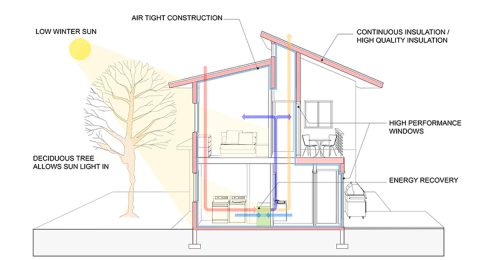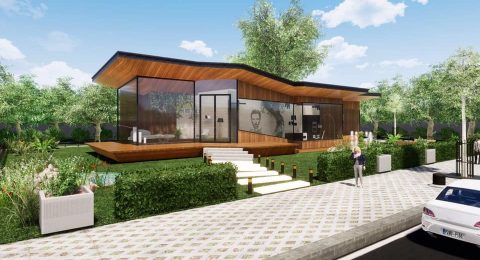By: Sara Mohamed & Mahmoud El-Zahwey
If you are considering going green, you are seemingly pondering to curtail your impact on Earth; this might be a really noble and necessary matter to look at when you learn how much our planet has already endured. However, if you thought about investing in an eco-house for this ground, you will not only help preserve the environment, but you will be able to minimize both your environmental impact and financial outlay while bolstering your quality of life quite significantly.
With a handful of factors to consider, some property experts see eco-building a complicated endeavor, whilst others deem it a very promising investment opportunity, particularly in the near future. Invest-Gate thoroughly examines these interrogations to assure that the full diversity of eco-housing is well comprehended through its numerous interdependencies, materialities, and multi-scalar practices.
What is Eco-Housing?

Eco-housing is more than just energy saving or environmental conservation efforts; the concept takes sustainability practices to a whole new level, starting from the usage of recyclable and sustainable building materials to the construction process, and ending with a healthy and eco-friendly lifestyle that targets reducing wastes and maximizing positive impact on the environment.
An eco-house is typically built using natural construction materials, including mineral wool, cork, or clay, with the fusion of smart strategies such as underfloor heating system or proper thermal insulation, going green, and depending on renewable energy resources, which will consequently help in reducing the house’s overall energy consumption and wastes, in addition to cutting its harmful carbon emissions.
Several other factors count; a study by Dovetail Partners – titled “What’s New in Eco-Affordable Housing?” – found that smaller-sized houses are more environment-friendly compared to larger ones, while other reports showed that trivial details like designing a higher ceiling or deciding on the placement of certain types of windows could contribute markedly towards the creation of an eco-friendly house.
British daily newspaper The Guardian published an article in 2003 that lists some developers and architects, who built multiple eco-homes across the globe, highlighting the German developer WeberHaus’ exceptional eco-friendly house – which greatly minimizes heat loss via the use of highly insulating walls and triple-glazed windows, while also referring to techniques applied by US-based architect Craig Steely to a few buildings in San Francisco’s Bay Area such as photovoltaics, a solar domestic hot water system, as well as a zoned radiant heating system.
The Egyptian Model
For the time being, it seems like the Egyptian property industry is bearing some inching steps toward the adoption of the eco-homes concept. Back in November 2018, Mariout Hills Developments, a subsidiary of Mariout Hills Group, has unveiled adopting a new innovative technology called “Eco-Housing” to be implemented within its array of projects across Egypt, primarily at its residential project Swiss Ranch in New Alamein city, the first integrated eco-housing venture in the region.
adoption of the eco-homes concept. Back in November 2018, Mariout Hills Developments, a subsidiary of Mariout Hills Group, has unveiled adopting a new innovative technology called “Eco-Housing” to be implemented within its array of projects across Egypt, primarily at its residential project Swiss Ranch in New Alamein city, the first integrated eco-housing venture in the region.
Chairman of Mariout Hills Developments Ahmed Hassan tells Invest-Gate:
“The company is attempting to allow homeowners “to create a new way of life that fits the country’s requirements and demands while reducing overheads,” with its strategy being aimed at providing clean and low-cost water and electricity to grant residents long-term durability, a healthier living environment, and reduced energy costs.”
“This shall be achieved through the utilization of renewable energy solutions, including the installation of solar power systems, which minimize heating and cooling costs through the use of passive solar gain, in addition to the implementation of self-contained home sewage treatment systems as well as household wastewater recycling systems.”
As part of its stipulation to offer a sustainable life within gated communities, all of Mariout Hills’ compounds adopting the Eco-Housing strategy also provide land areas dedicated to growing organic food, in addition to organic cattle farming.
Concerning units’ prices and targeted clientele, Hassan says:
“The company is offering “the least prices and the highest standards of housing that operate to reduce costs while providing all kind of luxury ever seen in Egypt and the Middle East,” interested buyers are required to pay an average price per unit starting from USD 50,000 and up to a maximum of USD 150,000.”
“Eco-homes are primarily developed for driving foreign investments, and Mariout Hills is mainly targeting foreigners from north European countries.”
“There was an unprecedented turnout for foreign investors towards New Alamein’s Swiss Ranch, attributing the soaring demand to the terrible weather as well as high cost of living in their homelands, which is offset by Egypt’s pleasant weather and cheaper living conditions.”
Critically Interrogating Eco-Homes in Egypt
When asked if the Eco-Housing technology can be implemented elsewhere, Mariout Hills’ chairman said the eco-friendly strategy can be applied anywhere, revealing that the company has received many requests from the Egyptian public and private sectors’ firms for its application within their New Administrative Capital’s (NAC’s) projects.
On the other hand, other Egyptian developers were mostly unable to follow such complicated eco-housing strategies. Hussien Sabbour, chairman of Sabbour Consulting, reckons that the application of the eco-house strategy is facing numerous challenges in Egypt’s real estate industry as the extra expenses directed to the project’s implementation, in most cases, trigger price escalation of units.
Despite the major hurdles holding back the North African nation from progressing in this field, some property developers started customizing their projects to match the world’s environmental standards. They have taken some slight, yet considerable, steps forward in this regard such as establishing vast green areas in their residential projects and using renewable energy sources, specifically solar power, to lower the compounds’ carbon footprint and reduce their energy needs.
Egypt-based Misr Italia Properties, for example, has created a world of lush luxurious greeneries of vertical forests and quiet meadows in its NAC residential project, IL BOSCO, labeling it an ecological haven at the heart of the new capital, while Castle Development and El Makassa have managed to design modern, spacious homes that temper rays of sunlight and use solar energy as the main source of lighting in their NAC’s Castle landmark compound.
Read this feature on pages no. 40 and 41 at our February issue.